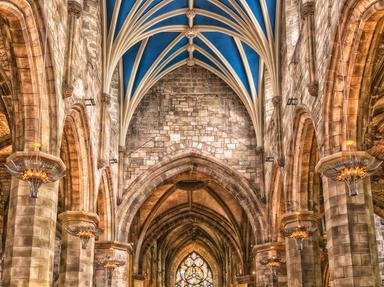Quiz Answer Key and Fun Facts
1. Built on a hilltop in central Italy, this magnificent, world-famous abbey was the first monastery of the Benedictine order, and one of the country's oldest. Though destroyed in 1944, it was rebuilt after the war. What is this site's name?
2. Another Benedictine abbey, Sant'Antimo, is considered one of Italy's most beautiful - both for its stunning Romanesque architecture and its idyllic location, near the town of Montalcino. In which Italian region, renowned for its wine, landscape and Renaissance art, would you find this lovely landmark?
3. The name of this spectacular Eastern Orthodox monastery complex, Meteora, translates as "lofty" - not surprising, as each monastery is built on a group of natural pillars of rock dominating the surrounding valley. To which Southern European country would you have to travel to visit it?
4. The Cistercian monastery of Orval, in the French-speaking Belgian region of Wallonie, is famous not only for the beautiful Gothic ruins of the old abbey, but also for a delectable commodity produced there. What heady substance am I talking about?
5. The spectacular Benedictine Abbey of Mont Saint-Michel is located on a tidal island off the coast of which historic region of France - well known to history buffs for its connections to England and its role in World War II?
6. One of the world's richest libraries is housed in the dissolved Benedictine Abbey of Saint Gall, located in which wealthy landlocked country?
7. The monumental Benedictine Abbey of Pannonhalma in Hungary is the second-largest territorial abbey in the world. Which venerated saint, a former soldier known for having shared his cloak with a beggar, was said to have been born in the vicinity of this imposing religious building?
8. The magnificent murals covering the façade of Voronet Monastery have earned this religious building the nickname of Sistine Chapel of the East. Where in Europe would you find this beautiful Orthodox site?
9. Celebrated for its extravagantly ornate Gothic architecture, the Monastery of Alcobaça was established as a gift from the King of Portugal to Bernard of Clairvaux - one of the founders of which important religious order?
10. In the Middle Ages, Great Britain was home to hundreds of convents and monasteries - most of which sadly lie in ruins. One of the few buildings that still survive to this day is this imposing Gothic church, a former Benedictine monastery, found in which famous southwestern English city?
Source: Author
LadyNym
This quiz was reviewed by FunTrivia editor
stedman before going online.
Any errors found in FunTrivia content are routinely corrected through our feedback system.
